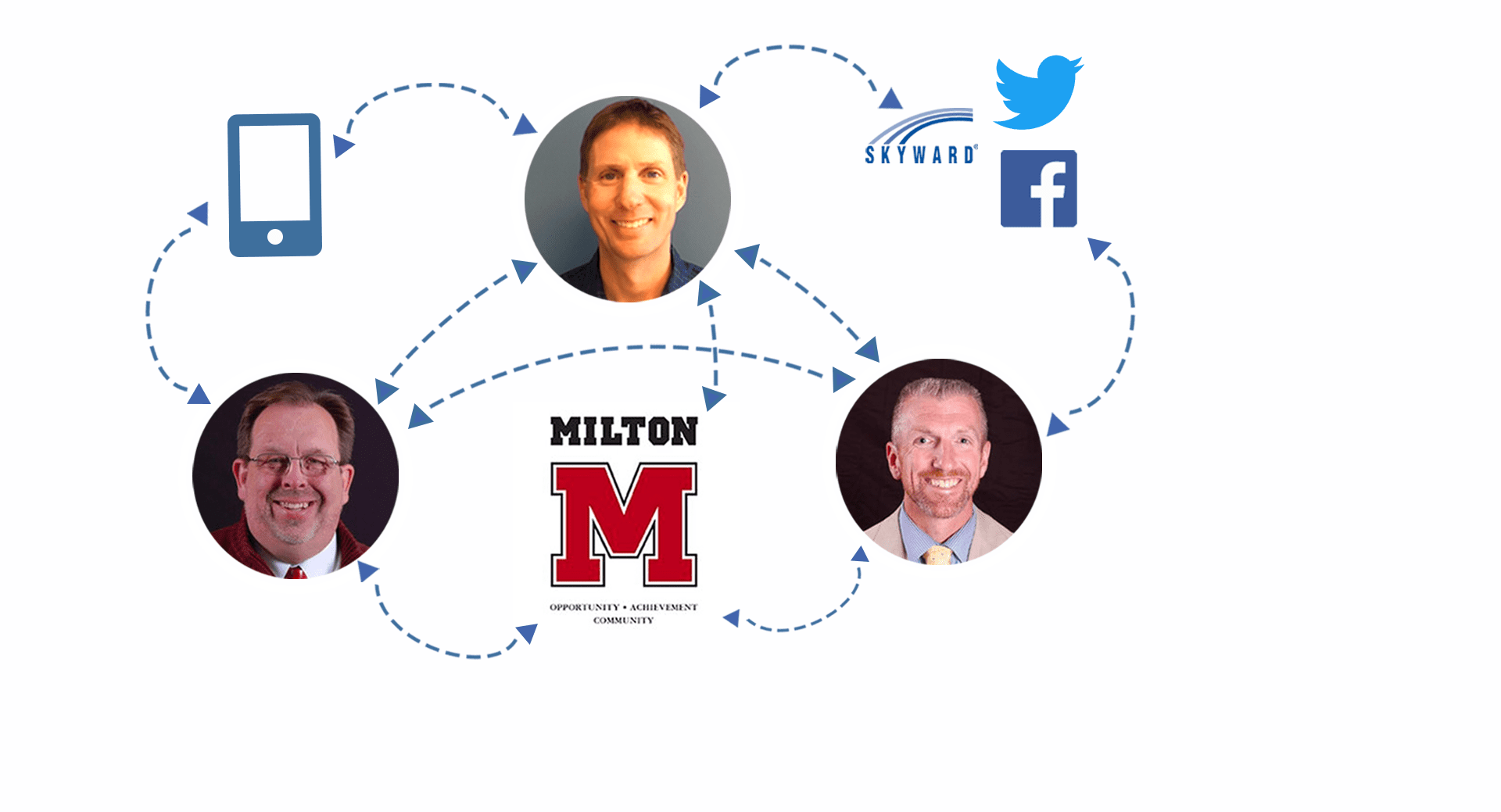Guest Post: Communications Done Right
BY School District of Milton
Editor’s note: In 2015, the School District of Milton (WI), featuring 8 different schools, 3,500 students, and approximately 600 staff members, was recognized as a leader in the field of school communications. I recently spoke with three key members of the district’s leadership team to find out the secret to their success. Has this emphasis on building a culture of communication led to a better learning environment?
John Jennings (AK12ET Editor): In most cases, the first step toward making communication a priority is bringing in a dedicated communications professional. What led the School District of Milton to create the position of communications supervisor?
Ed Snow (Technology Supervisor): For many years, I was filling the communication needs – website updates, notices to families, managing our Facebook account. It fell to me by default, even though it was not my background or chosen profession, and it became a significant burden to do it well. When Tim approached me with the idea of bringing in someone to manage that aspect, it sounded like a great partnership.
Tim Schigur (Superintendent): When we look at all of the different uses of technology in schools now, you need dedication if you’re going to do it well. We always had good intentions, but not enough manpower to meet our own expectations. There came a point when we were at maximum capacity and we weren’t happy with the quality of service being provided internally or externally. I could tell that the communications demands were stretching Ed too thin, so it was easy to justify a communications professional.
Jerry Schuetz (Communications Supervisor): I was excited for the opportunity to work with people who care so much about kids. As a former chief of police and city administrator, some might think I’ve moved on to something easier, but I don’t work any fewer hours in this job. All school districts have a story to tell, but they’ve historically been closed systems. We’re struggling financially to keep doing what society expects from the system with fewer resources, which is why I think the ability to effectively communicate that story is so important.
There was some initial resistance to the position. People wondered whether it was really needed. That reluctance has been overcome by positive experiences. People have started to open up in my third year here and have become very receptive to the support I can offer.
How did things change after Jerry came on board? What were some of the first steps?
Tim: Our website was the first priority. There had been too many hands involved – in filling this role, Jerry was going to be the point person for the site. We also wanted to put together a system for communication flow – who was the point of contact for all of these different mediums. This position helped us define the pathways, so we knew these things were covered.
Ed: The website was actually ready to go about six months earlier, but timelines suffered due to the amount of work on my plate. With Jerry coming on board, we were able to move faster.

Jerry: Now, we have 283 active pages on the website. The training I received from Ed when I first came on was essential – this was my first time working on the technical side of digital communications. We collaborated to cover both the clarity of the message and the format it was delivered in. Perception is established by what our stakeholders see of us, and we wanted to make sure we were putting our most positive face forward.
What does your strategic planning look like now? Who makes your communication decisions throughout the district?
Tim: I am still heavily involved in big communications decisions, but I have made it a point to give autonomy to individual buildings/departments. Everyone is given latitude within the big picture to get the message out on their own. Internal culture plays a big role in the district’s success. Building principals will now call Jerry or Ed for feedback, but they make their own decisions within the agreed-upon norms.
Ed: Our role is in getting the message out, not making the decisions about what the message is.
Jerry: Ed and I have been able to develop a bit of a support role for the buildings. Ed will explain the logistical part, I will try to determine the best course to raise awareness and make sure parents understand what is being communicated when they are the target audience.
One great example of this was a principal who called me to say, “Hey, I got a call from the newspaper, I want to make sure I get this right.” He came down to the district office and we called the reporter together. The result was a very positive front-page story.
You mentioned district culture, which I think is a critical component of any communications plan. What were some of the steps you took to encourage your staff to try new things and contribute to your communications plan on an individual level?
Tim: It was equal parts setting the expectations and providing an environment where everyone had the best chance to succeed. First, we set up an identity team within the district to define district-wide branding vs. individual school identities, and then we had open conversations about how much fidelity to district branding would be utilized in social media. We set the expectation to try out social media by using it for at least one communication per day.
On the technical side, we worked out some templates – the basic nuts and bolts for every homepage and social media account. These were just meant to be a common denominator, with room to go above and beyond. Jerry worked with principals/secretaries to help them build a pattern of communication into their schedules throughout the course of a day.
Ed: During that first year and a half, there was a lot of “is that you or me?” between myself and Jerry. We had a number of pleasant, productive conversations that helped us define responsibilities as we went along.
Jerry: Once everyone became more comfortable with those workflows, the culture of communication almost became contagious. When people see other teachers/schools actively participating on social media, they want to jump on board. Our nutrition team even set up a Twitter account for high school students to jump on and find out what’s for lunch today.
You’ve mentioned Twitter, Facebook, and the district website as three of the mediums you use. Are there any other platforms that play a key role in your efforts?
Jerry: YouTube is one medium that we’ve put some time into recently. We never used to videotape our board meetings and we’ve evolved to livestreaming them on our YouTube channel. I give credit to Ed on that for his willingness to work harder and try new things. We’re also making 2-4 minute video highlights of what’s going on in the district and pushing those out through YouTube.
We still use newspapers and other non-digital mediums and that’s so important because not everyone is necessarily connected.
Ed: We use Skyward and SchoolMessenger for most of our communications to parents. We require the use of Skyward’s online registration program, so we know that 95% of families have a Family Access account. Because of those numbers, our digital communication pretty much starts and stops with Skyward.
Jerry: We sent out a survey in which 71% of families indicated that their preferred method of communication is Skyward Family Access.
Tim: Skyward is the backbone of our communication efforts.
How do you determine the best way to reach a maximum audience and provide multiple touch points for important messages?
Jerry: I will talk to the kids at school and ask them where they like to go when they’re on their phone. 76% of our students have a smart device. Instagram and Twitter are the big networks for students; Facebook for parents. I rely on analytic reports to tell me how far-reaching our efforts are, and then pass those along to Tim and on to the school board.
Ed: I’ve been here for 15 years and throughout the first 5 of that we did not have automated phone dialing. For 8 of the last 10 years, I was the only one who knew how to do the robocalling. Since we started tweeting, I can’t get the robocall out fast enough. People are waiting for the phone call already knowing that school is cancelled due to social media. What a great problem to have.
We now communicate so much faster and so much more efficiently, and we’re no longer reliant on one person who happens to know the tech. We’re a district of 3,500 kids and we have 5,000 followers across our social media platforms. There’s some cross-platform integration involved, for sure. Our Twitter feed on the website is a good example – we can get multiple exposures to Tweets that people might not have been online to see at the time.
Tim: I have 725 followers on Twitter, and almost all of them are high school kids. When I push something out, I know Jerry’s doing it through the district feed and Facebook account, too. We disseminate similar information through all of our different mediums to ensure that it hits as large an audience as possible. That consistency and commitment ensure that we’re spreading our message. It gets busy on a day-to-day basis and it’s not always easy, but you have to make a concerted effort to do it.
Serving up lunch with @99Cramer at East...#SDMNutritionTeam #SDMTalent! pic.twitter.com/h7n57MvNJB
— Tim Schigur (@SuperinTIMdent) January 5, 2017
Why do these communication efforts matter to your students?
Tim: You can’t really teach responsibility unless you’re modeling it. With our 1:1 program, we have to ask ourselves if we are out there modeling what good digital citizenship is. Having a presence helps us both showcase and model that behavior for the kids and the community.
Jerry: Last year, we were fortunate enough to be recognized by the Wisconsin School Public Relations Association for excellence with our social media integration and 1:1 program. It was the highest such recognition attainable in the state. That means a lot to us, but what’s most rewarding is hearing from families, “I always look forward to those emails… I really like that new newsletter you send out… I appreciate what you’re doing with the emergency text system.”
We’ve seen a 500+% increase in social media engagement, and that’s been largely driven by the students and parents. They’re more engaged with what’s going on in the school community. Knowing that people value what happens in our school district is all the validation we need.
It’s pretty neat that these communications are so global. Social media affords us the opportunity to help relatives from around the world see what children are doing inside our schools. A grandma in Pennsylvania can weigh in on a student’s accomplishment in Wisconsin. Tech affords us the ability to do that. When we were kids, it was exciting to have our name in the newspaper, and digital media elicits that same kind of pride.
It sounds like you have a tremendous foundation in place. What are you doing to make sure this success is sustainable?
Tim: First of all, the three of us have to remain on the same page. Jerry and Ed are connected to their respective field organizations, including CoSN and the Wisconsin School PR Association, so I know they’ll have a good handle on any new trends that come along. We’re pretty good at “cutting the crap” and determining what we need. We’ll sit down and have the conversation about any new ideas – can we just go do it, do we need to phase it in, etc…
The three of us working together in an unabridged way is the only way this works. Once you mess something up, it’s 100-fold to try and undo it. It’s about not thinking that we have all the right answers, but having an open mind and demonstrating humility.
I have to give props to the innovations that come from Ed and our technology department. This summer, they got a drone camera and it’s been absolutely loved by our students and staff. We’ve used it at homecoming, assemblies, and other events. We’re also working on implementing a student-developed app to provide updates on our sports/extracurriculars in real-time. We’re constantly looking to create that next new medium where people want to be. I know that these two guys are going to come up with the next big idea to make it even better.
Ready to up your communications game? Get inspired by following the School District of Milton and two of their go-to resources, WSPRA and CoSN.
WHAT'S NEXT FOR YOUR EDTECH? The right combo of tools & support retains staff and serves students better. We'd love to help. Visit skyward.com/get-started to learn more.

|
School District of Milton Building a Culture of Communication |




